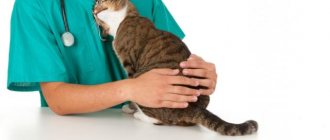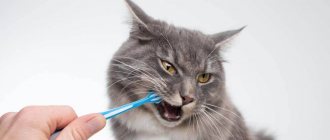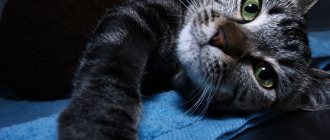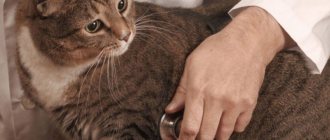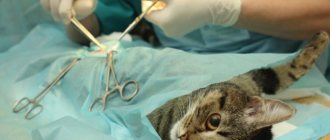Disorders in the nervous system of animals lead to epilepsy. It is believed that epilepsy attacks More often than not, dogs are “attacked,” but veterinarians are increasingly involved in saving representatives of the feline kingdom from such a scourge as epilepsy. Epilepsy in cats manifests itself with many symptoms, such as fainting and convulsions during an exacerbation.
Treatment of this disease should be carried out under the supervision of a veterinarian. The pet owner is entrusted with the mission of caring for the animal; he must also strictly follow the instructions of the attending physician and know the rules of behavior and handling of the cat during a seizure. You can learn about all this from this article.
Description of the disease
Epilepsy in animals is similar to a similar disease in humans.
It appears suddenly: the cat, for no apparent reason, begins to worry, walk or run around the room aimlessly, then the look becomes absent, the animal falls, and begins to convulse. A clear sign is the appearance of white foam in the corners of the mouth, sometimes mixed with blood. The attack lasts no more than 5 minutes, then the animal gradually comes to its senses and returns to normal life. Epilepsy is controlled with medications. The animal will be able to lead a normal life. Regular examination by a doctor is necessary.
Treatment
Treatment for epilepsy depends on its form. For primary epilepsy, special anti-epileptic drugs are prescribed, which are often intended for lifelong use. Secondary epilepsy involves recognizing the disease that causes seizure activity and then combating it. For example, in case of liver pathologies, the veterinarian treats the liver; in case of problems with blood vessels, the veterinarian focuses on the blood vessels.
Primary
Before treating true epilepsy, the pet owner must understand that this pathology cannot be completely cured. In the primary form of epilepsy, only maintenance therapy is possible, maximally relieving symptoms and shortening periods of convulsive activity.
For primary epilepsy, the cat is prescribed anticonvulsant medications.
Medicines
The drug options that veterinarians prescribe for most animals with epilepsy are listed in the table.
Table 1. Anti-epileptic drugs for cats
| A drug | Description |
Phenobarbital | The medication is the most popular remedy in the fight against epilepsy. Effective in reducing the frequency of seizures. Among the negative aspects of the drug, one can note a pronounced sedative effect and a negative effect on the general emotional state of the pet. Some owners have noted an increase in irritability in their cats with periodic use of Phenobarbital. This drug also sometimes helps increase appetite. |
Libromide | The medication is used to combat the most severe attacks of epilepsy in animals. The drug is non-toxic and does not inhibit liver function. Among the side effects can be identified drying of the skin, most clearly manifested in the appearance of cracks on the cat’s nose and paw pads. Used in both combination and mono therapy |
Gabaletin | The medication is aimed at reducing the production of neurotransmitters, which leads to a significant reduction in “extra” signals sent by the animal’s nervous system, leading to seizures. The exact dosage of the medication should be obtained from your veterinarian. On average, per kilogram of animal weight there are from 5 to 10 milligrams of the substance, given to the pet once every half day. Side effects are rare and include poor coordination and constant drowsiness. |
Zonisamide | An anticonvulsant medication that reduces the number of seizures by reducing the severity of synchronized neural excitation. Used by both animals and people. Designed for a long period of treatment with a gradual reduction in dosage |
Features of therapy
Since complete relief from seizures is impossible, the result that is considered positive is one that reduces the number of seizures by fifty percent or more. Also, the effectiveness of treatment will be manifested in a reduction in the severity of symptoms, a reduction in the phases preceding the immediate attack and the phases following it.
Properly selected therapy helps to increase the interval between attacks
In cases where long-term treatment does not give a satisfactory result, the veterinarian reviews the selected drug support regimen. The main reasons for the failure of therapy are the following:
- incorrect diagnosis;
- incorrect dosage of a particular drug;
- incompatibility of medications selected for combination therapy;
- premature addiction to the drug or intolerance to it.
The owner of an animal with epilepsy must clearly understand that making adjustments to the medications prescribed by the veterinarian and their dosage is strictly prohibited. Such actions can lead to a sharp deterioration in the animal’s condition and other unpredictable consequences.
During treatment, it is important to adhere to precise dosages of drugs
Reducing the prescribed dose is possible, as a rule, only after a year of successful treatment with stable positive results. Further, if your cat looks healthy and feels well, it is strictly prohibited to decide on your own to stop taking medications.
Forecast
The results of treating animals with epilepsy depend on the factors that led the pet to this disease:
- with primary epilepsy, the prognosis is positive, but cautious, since much depends on correctly selected therapy and its compliance by the owner;
- with secondary epilepsy caused by treatable diseases, the prognosis is positive. As a rule, when the disease that provokes epilepsy is cured, the attacks themselves disappear;
- with secondary epilepsy caused by pathologies that themselves pose a serious threat to the life of the cat, the prognosis is often unfavorable. Such pathologies include malignant tumors of the brain, severe systemic diseases (such as Addison's disease) and developmental abnormalities of the brain.
Prognosis for epilepsy depends on its course
Why is epilepsy dangerous?
Epilepsy is a signal that significant negative changes are occurring in the pet’s body.
The main danger of the disease is uncontrolled convulsions, due to which the animal can:
- hit hard;
- bite your tongue;
- start to choke;
- choke on saliva.
If the attack begins on the street, the cat may get hit by a car, fall from a height (for example, from a tree), or be attacked by dogs.
One-time, less often regular seizures are possible. If a cat remains unconscious for a long time, then refuses water and food, becomes very weak, and without proper assistance, there is a possibility of the pet’s death.
Emergency call to the veterinarian
Epilepsy is not a life-threatening condition. The danger lies in the injuries that a cat can receive during an attack, for example, falling out of a window, hitting the leg of a chair, etc. Therefore, the main goal of the owner’s actions is to prevent them.
But there is a concept of status epilepticus, which requires emergency contact with a veterinarian. This condition is characterized by several attacks in a row, between which the animal does not have time to recover. In the absence of veterinary care, each subsequent attack can cause:
- changes in brain tissue that are irreversible;
- asphyxia;
- hypothermia (a decrease in body temperature to a level insufficient to maintain normal functioning of the body);
- acidosis (increased acidity);
- heart failure.
Seek veterinary help immediately if:
- the duration of the attack is 5 minutes or more;
- the number of seizures has increased;
- the interval between attacks is too short (status epilepticus).
Causes of epilepsy in cats
The cause of congenital epilepsy is not fully understood. It is associated with improper nutrition of the mother cat during pregnancy or aggravated heredity.
Acquired epilepsy in cats occurs as a consequence of previous diseases:
- meningitis;
- peritonitis;
- diabetes;
- encephalitis;
- leukemia;
- heart, kidney, liver diseases;
- serious poisoning.
Sometimes epilepsy becomes a reaction to medications while treating an infection.
The development of the disease is provoked by poor nutrition. When a pet does not receive enough minerals, vitamins, nutrients, and often eats raw fish, the risk of epilepsy increases.
What is status epilepticus?
Epilepsy itself cannot cause the death of a pet. A serious danger to the life of an animal is status epilepticus - a condition in which convulsive seizures are repeated one after another, and between them the cat does not have time to regain consciousness. Epistatus is dangerous because it leads to a serious load on the brain, as a result of which the pet develops severe neurological disorders and significantly reduces life expectancy. This condition requires immediate surgical intervention. Ignoring it inevitably leads to the death of the animal.
Symptoms
Pronounced signs of epilepsy are convulsions, a “glassy” look, and abnormal behavior of animals.
Prodormal phase
A harbinger of epilepsy is a sudden change in the cat’s behavior. The animal follows its owner, purrs, rubs against its legs - actively attracts attention to itself. Or he demonstrates disorientation indoors, cannot jump onto high ground, starts screaming loudly - shows severe anxiety.
When there are no obvious causes for the conditions described, it is worth monitoring the pet and not leaving it alone.
The initial stage lasts 5-10 minutes.
Period of convulsions
The cat stops abruptly, its body trembles, salivation begins, and involuntary urination may occur. She does not respond to the owner's voice or any external stimuli. The animal loses consciousness and convulses.
But not all cats have noticeable seizures. Sometimes the animal suddenly freezes, the body takes on an unnatural shape, since all the muscles are tense, but the cat remains conscious. Only the facial muscles can tremble noticeably.
The duration of the attack is up to 3 minutes.
Recovery period
When the acute period passes, the cat's body begins to weaken. The pet does not recognize the owner, is afraid of surrounding traffic, and may show aggression. Sometimes the animal runs to water and food and does not leave the bowls.
Usually the cat’s body recovers in 30-50 minutes.
Features of external manifestation
The disease can be recognized by its external signs, which are typical. But only a doctor can make a direct diagnosis.
Forms of the disease
Cats can be diagnosed with congenital or acquired forms of epilepsy. Both forms are characterized by the same symptoms. The only differences are in the time of the first attack:
- with congenital epilepsy, the first seizures may appear at a young age;
- in the case of acquired - at any age, more often after a certain event in the cat’s life.
Congenital or true epilepsy
Another name for congenital epilepsy is idiopathic. This form of the disease is the result of improper development of the animal’s nervous system even before its birth. In this case, the processes of excitation and inhibition that occur in the cerebral cortex are performed incorrectly. There are no pathologies or concomitant diseases. The most likely reasons are:
- inbreeding;
- chronic infections and intoxication during pregnancy.
Factors that contribute to the development of congenital epilepsy are also identified:
- hormonal imbalances;
- endocrine diseases;
- heredity.
During diagnosis, no abnormalities are detected in urine, blood, or cerebrospinal fluid (CSF) tests.
Most often, the trigger is a hormonal surge during puberty.
Acquired or symptomatic
Unfortunately, disturbances in the functioning of the brain can occur at any stage of a cat’s life, which means that no one is immune from epilepsy. The symptomatic form may occur as a result of:
- traumatic brain injury;
- the appearance of various tumors in the brain;
- viral infections (most often the development of epilepsy is promoted by plague and rabies);
- lack of nutrition of B vitamins and vitamin D (they are responsible for the normal functioning of the nervous system), calcium and magnesium;
- poisoning with chemicals, medications, gases, toxins of viral or bacterial origin.
Stages of an epileptic seizure
There are three stages of development of an epileptic seizure:
- The stage of harbingers (“aura”). A short and not always noticeable stage of the attack. It manifests itself in different ways, for example, an animal can:
- suddenly become restless, afraid of everything;
- do not react to light or noise;
- tilting the head to the side, which can cause the muscles to twitch, making it difficult for the cat to maintain balance.
- The phase of seizures (ictal stage). At this stage, the muscles contract, which is why the paws twitch (and not necessarily all of them, only one of them can twitch), the animal may lose consciousness, control over urination, and foamy saliva is released from the mouth. The cat's breathing becomes intermittent, heavy, and can be clearly heard. The heartbeat also increases.
During an attack, your cat may produce foamy saliva.
- Recovery phase (postictal stage). After the seizures stop, the cat is in complete prostration; she does not understand where she is and does not recognize her owners. The duration of the recovery phase is about 5 minutes. Some cats attack food and water during this period.
The stages may be erased, the symptoms less pronounced. It all depends on the characteristics of the cat itself.
The duration of the attack is about 3–4 minutes. The frequency of each cat is different, it is difficult to predict when the next seizure will occur. But it is worth remembering that too frequent attacks can lead to death. This is because irreversible changes can occur in the brain due to insufficient oxygen.
Video: grand mal seizure
Cats at risk
Although epilepsy can occur in any cat, it most often affects:
- animals with a similar disease in their pedigree;
- kittens whose mothers suffered a serious illness during pregnancy;
- kittens obtained from close relatives;
- survivors of chemical poisoning;
- have had infections, often with complications;
- cats that have been injured or stressed during pregnancy.
There is no age interval for the onset of the disease - seizures occur in kittens and adult cats.
Types of pathology
Depending on the cause, pathology is divided into 2 types: congenital and acquired. The first accounts for 30% of all detected cases. It is extremely difficult to diagnose and cannot be treated.
The acquired variety develops under the influence of external and internal environmental factors after the birth of the animal. In most cases, it has a favorable prognosis and recedes soon after the root cause is eliminated.
Diagnosis of epilepsy in cats
Only a veterinarian can diagnose epilepsy. This requires a long-term comprehensive examination. It requires a lot of strength from the pet and is an additional source of stress. According to experts, it is better to bring your animal for a preventive examination every year and undergo a minimum of mandatory tests. A comprehensive diagnosis of epilepsy should be carried out immediately after an attack.
Based on the results of the examination, the doctor will find out whether epilepsy is congenital or acquired. In the first case, recommendations will be given on how to keep the cat in normal condition, in the second - how to rid it of the disease through complex treatment.
History taking
When making a diagnosis, it is important to fully collect information about the pet:
- pedigree, hereditary diseases;
- previous vaccinations;
- nutritional features;
- medical card;
- a description of the cat’s daily life (are there other animals at home, is he under stress, etc.).
The doctor will definitely ask you to describe in detail the conditions under which the attack occurred, what preceded it, and how quickly the pet recovered.
Cat examination
The examination is carried out by a veterinarian.
First it will check:
- body temperature;
- pressure;
- pulse;
- lung condition (listening with a stethoscope).
The doctor will examine the condition of the fur, open skin, and palpate the abdomen.
Instrumental diagnostic methods
It is advisable that the cat be examined by a veterinary neurologist after an attack. He will do special tests (for example, the reaction to external stimuli is checked - light, sound).
The doctor will prescribe the following measures:
- electronic encephalogram;
- magnetic resonance imaging of the head;
- Ultrasound of the abdominal cavity;
- X-ray – if necessary.
In some cases, the cat will be given anesthesia before the test.
Laboratory diagnostic methods
At the clinic, the cat needs to undergo the following tests:
- general blood test, urine test;
- blood chemistry;
- blood sugar test;
- analysis for hidden infections;
- saliva test – if necessary.
The test results will help rule out diabetes, toxins, and hidden infections in your pet.
Diagnosis of the disease
At the slightest suspicion of this disease, it is recommended to show your pet to a veterinarian as soon as possible. The following information will help your doctor make a diagnosis much easier:
- Detailed description of the attack. It is important not only how exactly the seizure occurred, but also how long it lasted and what events preceded it. If possible, it is recommended to record the attack on camera.
- Information about all the diseases that the cat has ever had, as well as preventive procedures performed (vaccinations, deworming). In order not to miss important information, you need to take your pet’s passport with you to the veterinary clinic.
- Data on the health characteristics of the four-legged patient’s parents, if available. If the owner of a purebred cat maintains contact with the cattery or breeder from whom she was purchased, it is recommended to try to find out whether her ancestors had epilepsy.
How is epilepsy treated in cats?
Epilepsy can be cured when it is provoked by another disease or is acquired. Otherwise, the pet will need regular observation in the clinic, a comprehensive examination 1-2 times a year, taking medications, and following a diet.
Cats with epilepsy can live a long time, provided that the owners follow all the doctor’s recommendations and do not neglect treatment.
What to do during a seizure
To avoid the negative consequences of epilepsy, the cat owner needs to be attentive to the pet and monitor any sudden changes in the animal’s behavior.
If you notice that your cat is behaving strangely, stay with it, offer water, and create comfortable conditions.
If you realize your cat is entering the acute phase of a seizure, do the following:
- Open the windows in the room slightly to allow fresh air to enter - this will help avoid breathing problems.
- Stay alone. Too many people nearby will scare your pet. Small children and other animals should be isolated.
- Place the cat on a sofa or blanket spread on the floor. Any safe place without sharp corners will do. It is important that the animal does not hit or fall.
- During convulsions, the cat should lie on its side so as not to choke on its tongue. A person does not need to hold or specifically press on the tongue.
- Do not fix or hold the animal's paws or body. This can scare or anger your pet. Just be there.
- When the attack passes, do not pick up the cat. Place water and food nearby. If the animal wants, it will approach the food. There is no need to lift it and turn it over.
If you have the opportunity, videotape the attack to show your veterinarian. Record the stages of the attack over time, especially the period during which the animal has fully recovered.
When to contact a specialist
It is important to show your pet to a doctor immediately after an attack or the next day.
Typically the cramps last 1-3 minutes. If the attack is prolonged or the cat is very weak, it is better to see a veterinarian as soon as possible.
If attacks occur several times a day, you should consult a doctor immediately. The cat is in danger. Invite a specialist to your home so as not to expose the animal to additional stress due to a change in environment.
Treatment with drugs
Medicine for epilepsy can only be prescribed by a veterinarian. Do not self-medicate, since a preliminary examination before choosing a drug is mandatory.
Congenital epilepsy is treated with anticonvulsant drops or tablets. A prescription will be issued for 1 year after the examination. Then everything depends on the condition of the pet. After 12 months, you will need to take tests again and get tested. If there have been no attacks during this time, the dose of the medication will be reduced. In another 6 months it will most likely be cancelled.
If epilepsy is acquired:
- prescribe treatment for the disease that caused the problem;
- anticonvulsants are prescribed.
Usually, when the root causes go away and seizures do not recur, the medicine is discontinued after six months to a year.
There are cases when drugs are prescribed for life. Therefore, consultation with a veterinarian and constant monitoring of the cat are necessary.
Gluten Free Diet
The plant protein gluten is found in grains that are added to most dry cat and kitten foods. Since these animals are carnivores, gluten is poorly tolerated by their bodies. It interferes with the absorption of beneficial substances and vitamins, so it can provoke epilepsy in animals.
One additional way to get rid of seizures is to give your cat a special veterinary gluten-free or low-gluten food. It is sold in specialized pharmacies and pet stores.
Owners who prefer to give cats natural food should know the principles of a special diet:
- exclude raw, minimize cooked fish;
- exclude cereals (rice, barley, corn);
- diversify your diet with meat (chicken, beef, rabbit);
- Make sure your pet receives vitamins (special vitamin complexes as prescribed by the doctor).
How to treat kittens
Medical practice shows that adult cats are more susceptible to epileptic seizures than kittens. Congenital epilepsy will manifest itself no earlier than six months of age.
First aid for a kitten remains the same as for an adult cat: place it on its side on a soft, stable surface, do not restrict its movements, offer water.
Only a doctor will prescribe drug treatment. These are special anti-convulsant drugs, adapted for kittens, with a reduced dosage. If the kitten’s attacks do not recur, therapy is prescribed when it reaches one year of age.
If the kitten has a history of epilepsy or there is a high risk that it has suffered intrauterine trauma, it is better to feed the pet gluten-free kitten food for prevention. In agreement with the veterinarian, a comprehensive examination is carried out without waiting for the first signs of the disease.
What an owner should do during a pet seizure
When the owner witnesses an epileptic seizure , he must be prepared for this and be aware of how to behave at this time:
1You should not touch the cat during a seizure; it can scratch or cling with its teeth; it is almost impossible to release such a grip before the seizure ends. 2 Any strong smell or noise can prolong the duration of the attack, since the animal’s psyche is tense to the limit. 3If a seizure occurs in the room where it occurs, it is recommended to turn off the lights or close the curtains, but it is better to leave the room yourself. 4It is necessary to place something soft around the cat, for example, pillows, in order to avoid injury; it would be good, upon noticing the approach of a seizure, to immediately place the sick pet on the floor, covering it with soft objects. 5The misconception is that during an attack you need to fix your tongue. If the animal lies on its side, then suffocation cannot occur.
In order to understand and study all the nuances of handling a cat during an epileptic seizure, you need to listen to advice and instructions from a veterinarian, read relevant literature, and best of all, watch a video on this topic, which will clearly show the correct position of the pet’s body during an attack.
Even if the cat feels well, it should not be left alone outside and its exposure to nature should be limited. For safety reasons, it is recommended to keep a pet with epileptic problems in an apartment or house under supervision. If the unexpected happens, you can contact our veterinary emergency center and order an urgent call at any time of the day; a veterinarian will arrive within 40 minutes.
Features of caring for a sick pet
Because epileptic seizures occur suddenly, it is important to protect your sick cat by:
- do not allow sitting on open windows and loggias without supervision;
- do not let one out into the street;
- remove traumatic loose objects from the apartment;
- limit access to tall furniture (cabinets, tables, shelving);
- change your diet smoothly.
Try not to turn on bright lights or loud music in the presence of a cat. Do not play with the animal flashlight and laser pointer. Refrain from using New Year's flashing lights.
It is important to be attentive to changes in your pet’s behavior, not leave it alone for a long time and strictly follow the doctor’s advice, and do not skip taking medications.
How to behave when a cat has a seizure?
During an epileptic seizure, you should never touch the animal. Firstly, this is important for personal safety; during an attack, the cat may scratch or bite, while she herself will not be able to open her jaw. Secondly, any touch, noise or strong smell can prolong the effect of the seizure.
It is best to turn off the lights and electrical appliances, close the curtains and leave the room. Before doing this, it is advisable to place pillows or something soft around your pet so that he does not injure himself. If your four-legged friend has an attack on a sofa or chair, spread a blanket underneath to prevent injury to the animal if it falls.
If your pet has epilepsy, then you should limit his stay on the street or exclude him altogether. Seizures occur suddenly; if the animal is on the street unattended, it will be defenseless and may be injured. For example, falling from a tree or being caught off guard by an attack near aggressive dogs. It is better to keep a cat with such problems at home, although this, of course, does not guarantee his complete safety, but the likelihood of providing him with timely assistance is higher.
Prevention of epilepsy
Only acquired epilepsy can be treated.
Seizures of epilepsy in a cat can be avoided if:
- follow the vaccination schedule;
- carry out deworming;
- Limit your pets' time outdoors to prevent parasite infestation;
- do not allow the animal to come into contact with household chemicals and medicines for people;
- organize proper nutrition;
- Have your pet examined by a veterinarian annually.
Owners of a sick animal need to remember that with properly organized treatment and a life schedule, epilepsy in a cat can be controlled, and in some cases, cured.
Advice from veterinary neurologists
Experienced veterinary neurologists, based on their knowledge and their own long-term experience, share very valuable advice:
1There is no danger to the pet’s life if the cat does not lose consciousness during an epileptic attack. Despite this fact, examination at a veterinary center is still necessary. 2If a cat experiences fainting, the veterinarian who is observing the tailed patient prescribes anticonvulsants. It is recommended to take such drugs from 4-5 months to life, although the final verdict depends on the doctor. 3It is unacceptable to self-medicate using dubious knowledge acquired on forums or heard in casual conversations. 4Every living creature’s body is individual and reacts differently to the symptoms of the disease and to treatment methods. Therefore, an individual approach is required for each individual cat diagnosed with epilepsy; if this is not taken into account, irreparable harm can be caused to the pet’s health.
Epilepsy in cats is an extremely serious disease, but it can be controlled. The main thing is to contact a veterinary center at the first symptoms and use the help of specialists in this profile. There is no way you can do tests and ultrasound examinations at home on your own. To avoid making your cat suffer without the necessary help, entrust its health to experienced veterinarians.
First aid for an epileptic seizure
Short-term attacks, especially if they are relatively rare (occur no more than once a month), are not so dangerous for a cat. An animal can cause the greatest harm to itself during convulsions. Therefore, at the first signs (it is advisable to notice the beginning of a seizure even in the warning phase), the cat must be removed from any height (window sill, shelf, back of a sofa, etc. - if it is there) and placed in an open space, there should not be any sharp objects around or hard objects so that the pet is not injured during a seizure. Do not press the cat to the floor or put your fingers in its mouth, trying to fix the tongue. Firstly, it is useless - it will not stop the convulsions, and the animal will never swallow the tongue if it is positioned to the side. Secondly, a cat in a state of seizure can accidentally injure its owner.
Useful tips for gastrointestinal bleeding
- toilet paper for anal bleeding should have a soft and smooth structure so as not to injure the anal area, which can cause bleeding in the case of anal fissure and hemorrhoids;
- the use of toilet paper should be done with extreme caution, without unnecessary pressure on the anus, so as not to injure the area where the fissure or hemorrhoid is located;
- Untrimmed fingernails can also become a traumatic factor for the affected area.
- in addition, bleeding areas are entry points for infection and failure to comply with hygiene rules and constant trauma to the anal area threatens the occurrence of complications such as inflammation of the hemorrhoid or paraproctitis, which are already acute surgical pathologies and require immediate intervention by a proctologist or surgeon;
- to reduce the traumatic effects of feces during defecation, it is justified to use emollients based on petroleum jelly or another similar substance, which are applied immediately before defecation to the anus;
- It does not hurt to be careful and attentive while eating, especially for people with diseases manifested by gastrointestinal bleeding, since any object that cannot be digested in the gastrointestinal tract, or even unchewed food, can become a traumatic factor and cause bleeding;
- drinking a large amount of liquid prevents the formation of feces of a solid consistency, thereby eliminating the factor of trauma when passing through the anus. The recommended minimum amount of fluid to drink is 2 liters per day.
- Eating foods high in fiber plays a positive role in reducing the factors of trauma to the anus. This group of food products includes vegetables and fruits, dishes made from legumes and unground cereals. When consuming these products, the consistency of stool becomes elastic and soft, which facilitates its unhindered passage through the anus.
If, after observing all the listed precautions, bleeding from the anus has stopped, then you should still not neglect visiting a doctor, since the task of medicine is not only to eliminate the symptom, but also to find out its origin and cure its root cause, thereby preventing recurrence of bleeding.
